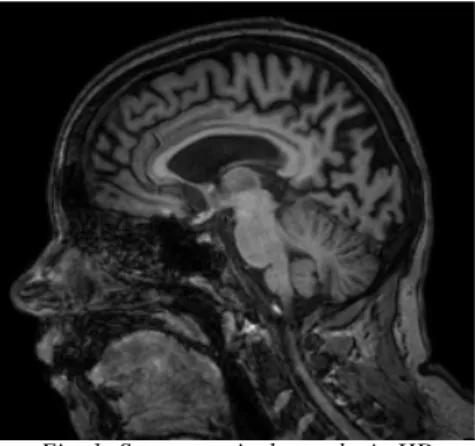III./3.2.2. Huntington’s disease
Huntington’s disease (HD), also called Huntington’s chorea, is an autosomal dominant neurodegenerative disorder affecting muscle coordination. HD leads also to cognitive decline and dementia. The symptom of chorea is not necessarily present, some patients have only transient chorea and present with more akinetic-rigid symptoms. The
prevalence of HD is 4-8:100,000, and there is no difference in genders. Symptoms start usually between the 3rd and 5th decade with an average duration of 10-15 years. The cause of death is the general deterioration of the somatic condition of the patient, which is associated with the usual secondary diseases. In about 10% of the cases, HD has a juvenile onset, and 20% belongs to the late onset mild HD. The specific genetic pathomechanism of the disease causes the phenomenon of anticipation: increasing severity and earlier onset are seen in consecutive generations of a family. For this reason, the juvenile form of HD presents with severe symptoms and a rapidly progressive course. The mutation responsible for HD was detected about 20 years ago. Genetic diagnosis, testing of family members not affected, and even prenatal genetic testing are routinely available.
III./3.2.2.1. Pathomechanism
The most prominent early changes are seen in a part of the basal ganglia called the neostriatum, which consists of the caudate nucleus and the putamen. Other areas affected include the substantia nigra, cerebral cortex, the hippocampus, and the Purkinje cells in the cerebellum. Striatal spiny neurons are the most vulnerable, particularly the ones that project to the external globus pallidus.
Fig. 1: Severe cortical atrophy in HD
The Huntington gene is on chromosome 4p16.3; at the 5’ end of exon 1, an unstable, polymorphic trinucleotide (CAG) repeat sequence is present. The expansion of this repeat sequence is responsible for the disease. Generally, the number of CAG repeats is below 36, with an average of 19. In patients with a mutated HD gene, the number of repeats is increased. A repeat size between 36 and 121 results in altered function of the gene. A repeat size of 36-39 is considered borderline, with unknown manifestations. The number of repeats and the onset and severity of the disease show an inverse correlation.
The higher the repeat number, the worse is the course of the disease, with earlier onset, more severe symptoms, and quicker progression. This phenomenon is called
anticipation.
HD belongs to the group of polyglutamine diseases. CAG is the genetic code for the amino acid glutamine, so a repeated series of CAG results in the production of a chain of glutamine known as a polyglutamine tract. When the length of the repeated section reaches a certain threshold, the polyglutamine tract produces an altered 3D form of the protein that tends to aggregate, forming neuronal inclusion bodies, toxic protein fragments or formations. These protein fragments can alter DNA expression or the protein-protein interaction with metabolic stress in the cell. The different functions of
these proteins are the cause of pathological changes, which lead to clinical symptoms.
The exact mechanism of the dynamically growing mutation and the instability of the repeat are still not understood.
1. Fig. 2: Genetic testing of HD, gel electrophoresis: from the left: positive control, negative control, patient’s sample
III.3.2.2.2. Clinical signs and symptoms
Clinical symptoms mainly affect three domains:
-motor symptoms (chorea, hyperkinesia, akinesia, rigidity, dysarthria)
-psychopathological symptoms (irritation, impulsivity, aggression, depression) -cognitive decline, dementia (loss of memory, slow data processing)
The spectrum of motor symptoms is wide, ranging from choreiform hyperkinesia to akinetic-rigid symptoms. The first motor sign is often a disturbance of oculomotor function followed by orofacial dyskinesia. At this stage of the disease, continuous grinning is characteristic. In later stages, dyskinesia appears in other muscle groups, such as the head, neck, trunk, and extremities; this is called generalized chorea.
Chorea is characterized by brief, quasi-purposeful, irregular muscle contractions that are not repetitive or rhythmic, but appear to flow from one muscle to the next; they can interfere with normal movements, with occupation and social life. In even later stages, bradykinesia, rigidity and dystonia may dominate, rather than hyperkinesia.
Cognitive impairment is already present at the beginning of disease course. The fields of memory, information processing and concentration are mainly affected. Additionally, personality changes, emotional instability are apparent, combined with paranoia and impulsivity in some cases. Due to these psychiatric symptoms, the risk of alcohol abuse and suicide is increased in HD. Depression at the onset of HD often turns into psychosis with hallucinations in the advanced stage of the disease.
Video 1: Huntington’s chorea, early signs of orofacial Video 2: Huntington’s chorea, generalized choreiform
dyskinesia. Continuous grinning is characteristic for HD.
hyperkinesia.
III.3.2.2.3. Diagnosis and medical care
Clinical signs and positive family history are the clue to diagnosis. The combination of characteristic hyperkinetic movements and neuropsychiatric symptoms should always lead us to ask for genetic testing of HD. It is an easy and inexpensive test.
If the genetic test result is negative, cranial MRI should be performed to rule out inflammatory, autoimmune or neurodegenerative CNS disorders. Furthermore,
comprehensive laboratory assessment is recommended to rule out metabolic or hormonal causes. As a further differential diagnosis, rare genetic conditions, such as mutations of the HDL1- PRNP or HDL2 - JPH3 genes and spinocerebellar ataxia SCA17 can be tested.
III.3.2.2.4. Therapy
There is no causal therapy available for HD.
Symptomatic treatment includes the following:
Depression – SSRI, mirtazapine, sulpiride (avoid tricyclic antidepressants)
Hyperkinesia – neuroleptic drugs like clozapine, olanzapine, tiapride, tetrabenazine, amantadine
References
Huntington's Disease Collaborative Research Group. A novel gene containing a
trinucleotide repeat that is expanded and unstable on Huntington's disease chromosomes.
Cell 1993; 72:971–983.
Phillips W, Shannon KM, Barker RA. The current clinical management of Huntington's disease. Mov Disord 2008; 23(11):1491–1504.

